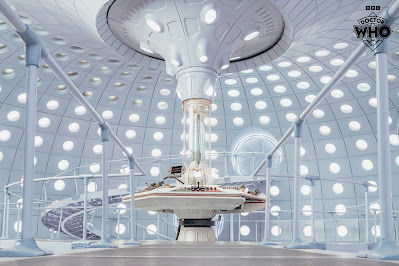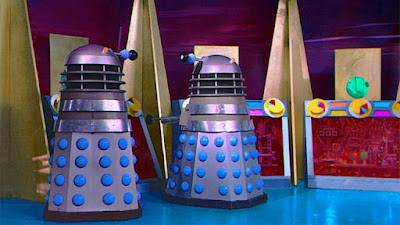One of the things we fans have is a knowledge of what went on behind the scenes on various Doctor Who stories. Some have a rough idea about the better known events, whilst others - and I count myself here - have a fairly in-depth understanding of the programme's history, thanks to reading a lot and absorbing all the extra detail to be found on the DVD releases, etc.
Whilst the casual viewer might watch a programme which appears to have been thrown together, has terrible set / effects, or is badly plotted, I know just why it may have come across that way on screen. It might not justify production decisions, but it does explain them as often as not.
Season 15 was particularly badly hit by two events totally out with producer Graham Williams' control - inflation and industrial unrest.
We saw how the former affected the previous story - Underworld. It was still a factor with the series finale, but added to this was the coincidence of a BBC strike.
This affected the studio work, so a lot more of the serial had to be made on location. This shows on screen - both in terms of the juxtaposition in image quality between film and video, and the nature of the locations themselves (a lot of brick walls in a futuristic space-time machine, for instance).
With The Invasion of Time, problems had reared their head long before the story went into production, however.
Script editor Anthony Read had offered the slot to an old friend, David Weir. A Gallifrey setting was requested, after the success of the previous year's The Deadly Assassin (and sets and costumes still existed, saving money). Weir came up with the idea that the planet's original inhabitants, who allowed the Time Lords to set up home there, were cat people. As cats like to play with and torment their prey, these cats would stage huge gladiatorial events. The script called for thousands of cat folk in an arena the size of Wembley Stadium. Did we mention inflation already...?
It quickly became apparent that the script was unworkable, but time was pressing. Williams and Read were forced to come up with a replacement at the last minute, keeping their Gallifrey location but ditching everything else.
BBC politics led to the story going out under the authorship of "David Agnew" - a pseudonym to be used if the writer wasn't supposed to be writing, or had withdrawn their name due to being dissatisfied with some aspect of a production.
As for the story itself, there was one other major headache to add to the others which had already plagued this production - the decision of the second lead actor not to renew their contract.
One thing everyone notices about The Invasion of Time is the hugely unsatisfying departure of Leela at the conclusion. From out of nowhere, she suddenly decides to stay in the rather dull and dusty environs of the Capitol to marry a man she has only just met and has barely interacted with throughout the previous six episodes.
If it's badly handled, it's because right up until the last minute Williams was hoping that Louise Jameson would change her mind. It was never going to happen - she had already signed up to play a pair of Shakespeare roles at Bristol Old Vic. She had already been compelled to suffer the antipathy of co-star Tom Baker for the last 18 months. He hated the character of Leela, and this crossed over to him being quite stand-offish with Jameson. The role was unrewarding, and the working environment was strained, so why put yourself through another year of it?
Williams and Read ought to have grasped this, so their lack of forward planning is hard to explain, let alone justify.
On to plot, and we can just about accept the Doctor taking Leela to Gallifrey so soon after him refusing to take Sarah. He is working under the malign influence of the Vardans, so isn't exactly tripping over himself to adhere to Time Lord rules or laws.
What doesn't make sense is his not dropping her off somewhere else first. On Gallifrey, he knows the risk she poses and has her thrown out of the Capitol at the earliest opportunity. Why bring her to his homeworld in the first place?
Whilst we have a reuse of set designs and costumes, the previous story had used a bit of TV trickery to show massed ranks of Time Lords in the Panopticon. The Capitol is rather sparsely populated in this story.
The relics of Rassilon - of which there are many - start to get a bit confusing. We heard about his key in the previous story, where it was identified as an ebonised rod which slotted into the floor and released the Eye of Harmony. That key is now the Rod of Rassilon, and the key looks like a conventional mortice one. Unless the Key of Rassilon and the Great Key are supposed to be two different things...
Other relics are introduced - like the coronet - or have new functions - like the Sash. It was implied in The Deadly Assassin that the latter was purely ceremonial and if it had a practical use it no longer works (it certainly didn't save the Lord President from being shot dead).
What is odd about these items is that K-9 - a machine - can use them to do what it does to eject the Vardans and time-loop them.
The Vardans travel via any form of wavelength, including thought - so why do they need a great big spaceship?
Why are the Vardans working for the Sontarans, and not the other way round? The ability to travel by thought etc. should have made them an invincible species.
When we finally get to see them, the image is greatly disappointing after the build-up...
Talking of Presidents, have the Time Lords really gone all this time without electing his replacement?
Borusa had previously specifically pointed out that it would not be a good idea for the Time Lords to be seen to be disorganised and leaderless.
It should have been obvious that the Doctor only invoked Article 17 to save his own neck, and never had any intention of actually becoming President of the High Council. Surely they weren't waiting for him to turn up again?
The space traffic control centre is one of the highest security areas on Gallifrey - but no-one seems to have thought about how the Transduction Barriers are powered. All you have to do is pop down the basement, knock out one guard, then blow up the machinery - and Gallifrey is defenceless.
Why do the people who have renounced life in the Capitol continue to live so close to it? With a whole planet to explore, you'd think they would have sought their new life well away from their old one.
A continuity gaffe is the Doctor wearing his scarf on the Vardan flight deck, whilst we can see it on the TARDIS hatstand at the same time, and he returns to the ship not wearing it.
The Sontaran two-parter feels tacked on at the end - partly in keeping with the Robert Holmes model of handling six part stories but also, presumably, a victim of the rushed rewriting process.
This also leads to a very confusing and underwhelming conclusion.
Much is made of how awesome the Demat Gun is, yet it simply acts like an ordinary laser rifle in the end. It is used to shoot two Sontarans, including Commander Stor, then the next thing we know the invasion's off.
If the weapon removed people and things from time, then that throws up all manner of paradoxes, such as how Stor could lead the invasion if he never existed in the first place. If the gun is sentient and can handle these paradoxes, then the story certainly never states it.
Stor knows all about the Great Key, but isn't aware that the Doctor and the President are one and the same. The entire invasion plan hinges on the Doctor becoming President. The Sontarans were employing the Vardans, so why did they not tell Stor this vital fact?
Why did Kelner try to destroy the TARDIS with the Doctor inside it - in possession of the key which Stor is looking for?
Why are there only a handful of Sontarans for such an important campaign as the invasion of the Time Lord planet?
Why was Stor put in charge of this mission, when he can't even put his helmet on straight?











































